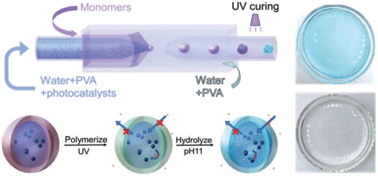Hydrogel microcapsules with photocatalytic nanoparticles for removal of organic pollutants†
Abstract
Droplet-based microfluidics is used to fabricate thin shell hydrogel microcapsules for the removal of methylene blue (MB) from aqueous solutions. The microcapsules composed of a poly(methacrylic acid) hydrogel shell exhibit unique properties, including permeation, separation, purification, and reaction of molecular species. Photocatalytic TiO2 and ZnO nanoparticles encapsulated in the microcapsules, i.e. photocatalyst in capsule (PIC), are used to remove organic pollutants using an adsorption–oxidation mechanism. A prototype flow microreactor is assembled to demonstrate a controllable water purification approach in short time using photocatalysts. Our studies of aqueous and homogeneous hydrogel environments for the photocatalysts provide important insights into understanding the effectiveness of MB removal. Hydrogel capsules have MB removal rate comparable to homogeneous particles. Further reduction of both capsule and photocatalyst sizes can potentially aid in quicker water purification.

- This article is part of the themed collection: Environmental Remediation


 Please wait while we load your content...
Please wait while we load your content...
